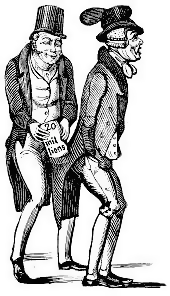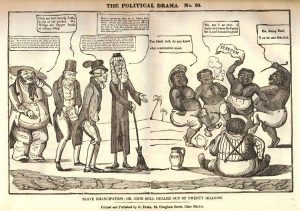A few years back I got into hot water for saying that the defeated Irish (and English) transported to Barbados after the Cromwellian wars were slaves. The vehement online response was that they were indentured labourers. Involuntary indentured labourers. With no fixed term to the indenture. At my nit-picking best, I said that forced labour without time limit sounded very like slavery to me.
How wrong I was.

In my utter up-from-the-country innocence I had wandered onto a battlefield in the ongoing Culture Wars. The kind of people who like to get together after dark carrying flaming firebrands have made it one of their central (idiot) beliefs that slavery was colour-blind: us whites have got over it and so should you African-Americans. Saying there were seventeenth-century Irish “slaves” in Barbados was the equivalent of putting on a white hood and lighting a nice big torch.
 What brought this back to mind was discovering University College London’s extraordinary ‘Legacies of British Slave-ownership’ website. When Britain abolished slavery in 1834, it did so by buying out every single slave in the Empire, paying the mind-boggling sum of £20,000,000 to the former slave-owners. The process naturally involved recording in detail every single one of the 46,000 compensation payments. All the records, including payees, amounts and locations, are in The National Archives in Kew.
What brought this back to mind was discovering University College London’s extraordinary ‘Legacies of British Slave-ownership’ website. When Britain abolished slavery in 1834, it did so by buying out every single slave in the Empire, paying the mind-boggling sum of £20,000,000 to the former slave-owners. The process naturally involved recording in detail every single one of the 46,000 compensation payments. All the records, including payees, amounts and locations, are in The National Archives in Kew.
What UCL has done with those 46,000 payments is remarkable. They have extracted and mapped the personal information – names, addresses, occupations, numbers of enslaved people – onto zoomable maps of Britain and Ireland. At a glance it becomes clear where slavery-derived wealth collected, who owned it, how much they were compensated. (Ireland appears to have had relatively few slave-owners).
This much is very interesting in its own right – the sheer social and geographic breadth of British slave-ownership is astonishing. But the project goes much further. It links the owners to the specific plantations in Barbados, Grenada and Jamaica from which they drew their profits and maps the plantations too. It looks at what the payees did with  their slave-compensation money, the industries it supported, the political careers it enabled, the cultural institutions it helped to found, the great houses it built. Later generations of slave-owning families are tracked through their careers in politics, imperial administration, the arts and education, with prominent individuals highlighted throughout – William Gladstone, the Prime Minister of Britain through much of the Victorian era, was the son of the recipient of the single largest compensation payment. John Gladstone owned no fewer than 2508 enslaved people in British Guyana and Jamaica in 1834.
their slave-compensation money, the industries it supported, the political careers it enabled, the cultural institutions it helped to found, the great houses it built. Later generations of slave-owning families are tracked through their careers in politics, imperial administration, the arts and education, with prominent individuals highlighted throughout – William Gladstone, the Prime Minister of Britain through much of the Victorian era, was the son of the recipient of the single largest compensation payment. John Gladstone owned no fewer than 2508 enslaved people in British Guyana and Jamaica in 1834.
What the project does is something very familiar to genealogists, the bringing of forgotten truth back out into the light, piece by painstaking piece. The forgotten truth here is that much of the apparent majesty of Britain’s industry and culture was founded on slave money, a fact quickly and conveniently buried by subsequent Imperial historians.
The site also makes clear what enslaved Afro-Caribbean people got in compensation for their generations of degradation. Nothing.
Very pertinent information and timely. Thank you for looking deep into this time in history.
Thank you for this very informative and very timely article!
Thank you for bringing this to light.
Sandy Laferriere ☘️
History is often inconvenient. Speaking of which, I wonder if there are any records of the names of the “captured” priests sent by the English to the Caribbean in the 1700’s. I assume they were not “slaves,” but were actually indentured laborers with an indefinite term…..
No, you were right initially. There were Irish slaves. That there were also indentured servants does not eliminate the slavery of others. The cadre that attacked you confound the facts by denying slavery other than chattel slavery, ie, slaves who could be bought and sold. The Irish slaves were just worked to death. They were not fit for purpose to toil in subtropical fields so were replaced quite quickly.
The arguments over the accurate depiction of slavery are far more sophisticated than “we got over it, you should too.” We must remember the vast majority of Irish immigrants in America made their homes in places where slavery was illegal, and that they filled the ranks of the troops that made it disappear.
John, No matter how much of a kerfuffle the PC police raise, you’re dead on. If it walks like a duck and quacks like a duck, it’s a duck. If it’s involuntarily transported/taken from its home, made to work for no pay, and not allowed to ever leave its place of employment, it’s a SLAVE. Period. The fact that Irish “slaves” had no market value is irrelevant – it would lead one to argue that if a black slave was born to an owner and never sold, they weren’t a slave, but a “family member”. Both arguments are patently ridiculous.
I’m totally enjoying your blog. I visited with you in June at the National Archives (unaware that I was sitting with John Grenham). We were looking for my 2xggp’s James Mehigan and Nora Sheehan (Cork, 1820’s-1880’s) and found not a thing – I’ve been on their trail for several years with the same result – NADA. I guess the only thing that will save me from a bloody forehead (from banging it against the brick wall!) is to be fortunate enough to find a DNA relative from that branch who knows more than I do. Long shot, I know, but it keeps me hunting. Thanks for your time that day. And it wasn’t totally wasted, as I had no idea that FamilySearch was wildcard-friendly!
I wrote an article two years ago with analysis of the claims and names of all 108 claimants (mostly landed gentry, clerics & merchants) who claimed near half million pounds – about 2.5% of the UK total – for c. 16,000 slaves, one-third from Jamaica, British Guiana 27% and Antigua 19%. I also gave country breakdowns; as well as urban areas, Mayo & Tipperary feature strongly. The largest claim is the largely unknown McGarel family from Larne who claimed the largest amount, c. £135.000 for 2,800 slaves (31% and 18.5% of Irish totals respectively). See http://www.iancantwell.com/pdf/15Irslave.pdf for detailed analysis of the database (https://www.ucl.ac.uk/lbs/) which may have been since updated
Transportees, indentures, and slaves were three different categories of bondage. The Irish fell into the first two, but not the third. John is right to point out the differences between the Irish and African experiences, and the sheer racism behind the ‘Irish slaves’ myth.
Its bad enough that so many Americans of Irish ancestry back this. What none of them notice is where it puts them in terms of ‘white’ status – those descended from English indentures or transportees are never included in this, despite vastly outweighing the Irish. So some ‘whites’ are more ‘white’ than others. Worse again, Irish people fall for this.
The 17th century Irish in the Americas were a varied lot but of course their actual lives are of no interest whatsoever to the Americans who push this meme – history never is for such folk. It also explains why John unwittingly blundered into this; its a thing in the USA because of current racial issues based on skin-colour dating back to the 1600s. Its not in Ireland because we don’t have those in-built issues.
The whole matter is, as John points out, everything to do with “ongoing Culture Wars” within the USA. But at the cost of abusing certain parts of Irish history. This must be fought.
Well, we should also rmemeber that a good many Irish settled in places where slavery was legal. They also joined the military forces not to maintain slavery, but more likely, simply to defend their homes and seek acceptance in the new land.
Many Irish slaveowners, if Catholic, also had their slaves’ offspring baptized…
Which is how the first African-American bishop in the USA was named Healy.
His younger brother Michael Healy was the commanding officer of all the Coast Guard squadrons assigned to enforce maritime laws, including the collection of import duties in the Alaskan Territory in the last 2 decades of the 19th century & was mentioned in the common history that I learned while staying with my spouse in the Armed Forces in Alaska 1971-1973.
https://en.wikipedia.org/wiki/James_Augustine_Healy